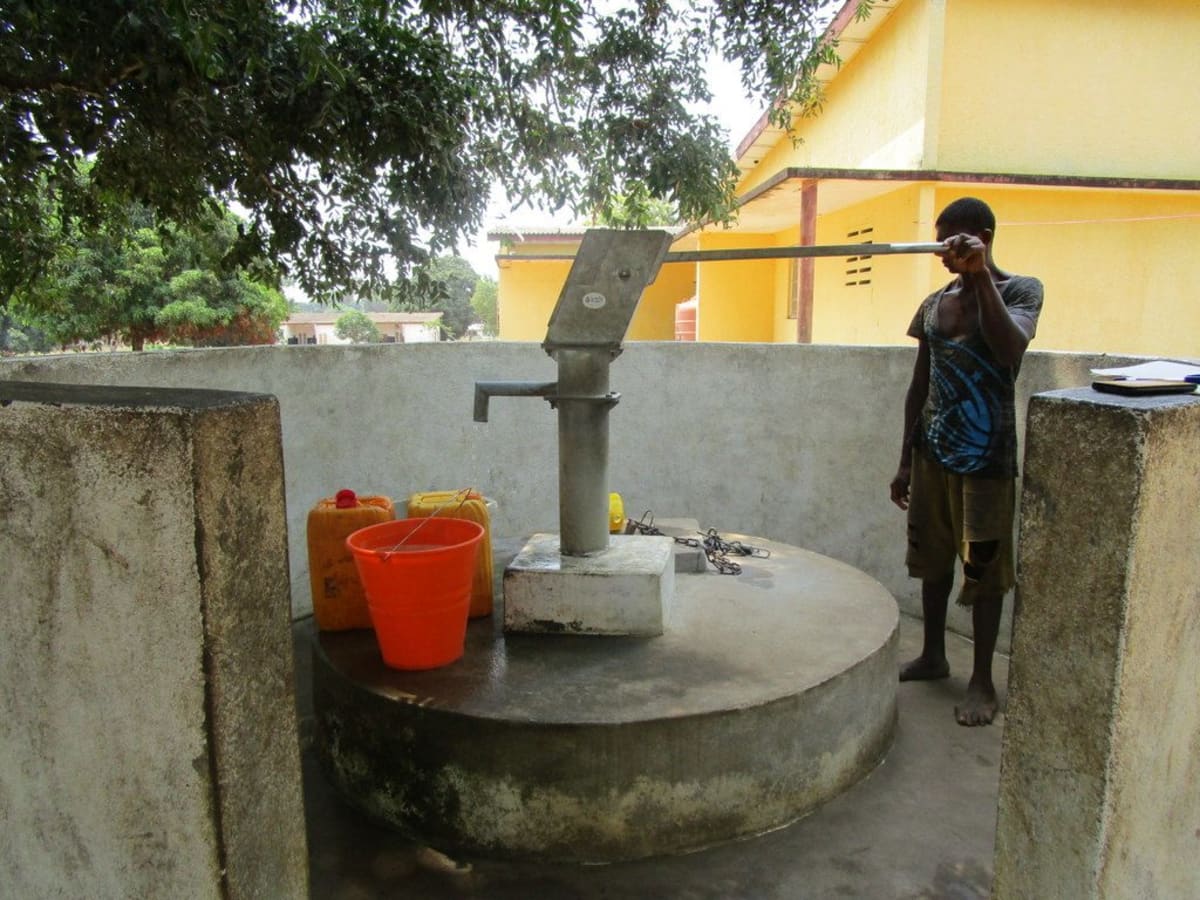Welcome to the Community
Tintafor, a small town in Sierra Leone, has a population of 545. (Editor's Note: While this many people may have access on any given day, realistically a single water source can only support a population of 350-500 people. This community would be a good candidate for a second project in the future so adequate water is available. To learn more, click here.)
People who live in the military barracks here have more safety and security compared with the rest of the community. The influence of the military lifestyle is apparent, as children are taught from an early age to live a disciplined life. They are expected to do chores in the morning because helping their parents is an expectation and a priority. Having a family member in the military is seen as a luxury for most children. The soldiers are entitled to two bags of rice at the end of every month. After their chores, children are given the choice of a pot full of leftover rice or a loaf of bread with a rice tea mixture.
Water Situation
During the months when the well identified for rehabilitation dries up, the community has to fetch water from an unprotected well. (Editor's Note: There are pictures of two different wells, one which is protected with a pump and one unprotected with no pump. There are two pictures of the well we plan to rehabilitate: one of the pump sitting idle, since there's no longer any water, and one of the well open and being prepared for work. The third picture is of a woman fetching water from the unprotected well.)
At the unprotected well, community members use five-gallon containers tied to the end of a thick rope to fetch water. The container is cut on both sides, which allows it to fill faster. Fetching water from the 20-foot deep well is physically demanding, especially for small children. The well is unprotected and open, which leads to contamination of the water with microorganisms. There is even mildew and grass at the surface of the well! The rope and container used to fetch the water are thrown on the ground, which contributes to its unsanitary conditions. The water source is also often contaminated by surface runoff, human and animal activities.
The fetched water is stored in drums for the people who live in the barracks. People in the military have more resources; they are provided with medical care and are equipped with water treatment methods. The rest of the community uses five-gallon containers, frequently without lids, to store contaminated water that is not treated.
The presence of contaminants in this hand-dug well's water leads to adverse health effects. The community outside the barracks purchases antibiotics from drug peddlers. The quality and appropriateness of these antibiotics is questionable and their use may contribute to the development of multi-drug resistant organisms.
Sanitation and Hygiene Situation
A quarter of the households don’t have access to latrines. For those that have access they are predominantly pit latrines with walls and roofs. (Editors Note: Open defecation — the practice of disposing human feces in the fields, forests, bushes, and open bodies of water — is an issue the community could potentially be facing). Compared to the rest of the community, people in the barracks are more diligent about cleaning the latrines. The community could be in this predicament due to lack of access. High levels of open defecation could have health related consequences including high child morality and malnutrition. More than 75% of households have bathing rooms. However, fewer than 25% of households have tippy taps or hand-washing stations. For some families, having a hand-washing station is not the problem; it is having access to cleansing agents, such as soap or ash that perpetuates unsanitary conditions. The soldiers’ barracks are well maintained and clean. At the end of the day, all trash is thrown into a hole and burned. The rest of the community throws garbage just few feet away into a banana farm. There is a cultural belief that the garbage will increase the banana production. Overall, the community has a positive attitude towards hygiene and sanitation and is excited to attend training.
Plans: Sanitation and Hygiene Training
Training will last for three hours a day for three days. The facilitators have already assessed sanitation here and decided that hand-washing and using the latrine will be strongly emphasized. Though a few hand-washing stations were observed during our initial visit, we require that each and every family have their own place to wash their hands. During our hand-washing sessions, community members will be taught how to make their own hand-washing station out of a plastic jerrycan, sticks, and rope. These are the best solution for rural areas, since all the materials are all easily replaceable. Though pit latrines in this community are well-built, we also require that every family have their own.
Training will also result in the formation of a water user committee that will take responsibility for their new well. The members will manage and maintain the pump to the best of their ability, and will call our office if they need a mechanic to make a repair.
Plans: Well Rehabilitation
The well marked for this overhaul needs major work to supply adequate, clean water to the community once again. The pump will be removed, and a man will be lowered inside with a hand auger. This hand auger will allow the team to drill several meters deeper to hit a new water table, which will ensure the well supplies water throughout the drier seasons. As the team drills, casing will be installed, transforming this hand-dug well into a pseudo-borehole. PVC piping will connect this lower system directly to the pump, a construction that we know will also improve the quality of water.
Once this plan is implemented, everyone within the community will have access to safe drinking water in both quality and quantity.

 Protected Dug Well
Protected Dug Well























